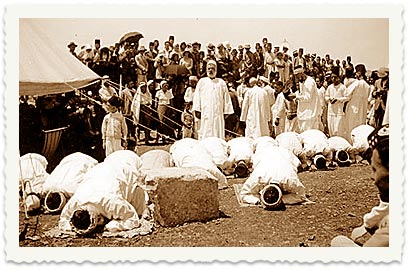Nablus Attractions
Old Town of Nablus

This remarkable old town in the city center is a bustling market, or Souq, with impressive mosques, Turkish baths, and traditional soap factories. Its architecture rivals that ofJerusalem. The Great Mosque, al-Kabir, is on the eastern edge of the Old Town of Nablus. West of the Great Mosque lies al-Shifa Turkish bath. Built around 1840, it is the oldest operating Turkish bath inPalestine.
Tel Balata – Shechem

Located 3 km east ofNablus, Tell Balata, or Shechem, was one of the earliest and most powerful Canaanite cities. Destroyed and rebuilt several times, the ruins of this ancient city occupy a hill rising 525m above sea level. A fortress temple on the summit of the hill is the largest and most impressive surviving Canaanite temple inPalestine. Other visible ruins include two monumental gates, massive city walls, and a governor’s palace with a small private temple, guardrooms, an assembly, living quarters, and a kitchen.
Jacoub’s Well

Located 1.6km south ofNablus, Jacob’s Well is where Jesus met the Samaritan woman who offered Him a drink of water. Jacob dug the well for himself, his children, and his flock on a plot of land he bought upon his return fromMesopotamia. The Crusaders restored it over the well. Today, it stands within the walled complex of the Greek Orthodox Monastery.
Neopolis – Roman City Ruins

The modern name of Nablus is a corruption of the Greek name. ‘Neopolis’, the new city, which was founded in 72 AD by the Flavian Emperors. The Roman city was built on the northern slope ofMountGerizim, ca. two km west of Tell Balata. The city developed as a major center in during the second century AD.
Major building projects were launched, including the hippodrome, the theatre and other public buildings. The RomantempleofZeuswas erected onMountGerizim. In some places excavations have revealed portions of these roman buildings and in some places these are still visible.
Gerzim & The Samaritans

Standing at 881m above sea level,Mt.Gerzimoffers a magnificent panoramic view of Nablus and the surrounding area. Ancient ruins at the summit include an octagonal church built by Zeno in the fifth century, and the remains of a mosque and a castle dating back to the time of Salah ad-Din. A small Samaritan community, inhabiting the plateau below the summit for the past 2500 years, holdsMt.Gerzimas sacred. Believing thatMt.Gerzim fitted Abraham’s description better than Mt.Moriah; the Samaritans built a rival temple to the one inJerusalem. Though the temple has long been destroyed, the Samaritans still point out a rock that they believe is the place where Abraham prepared to sacrifice Isaac.
The Olive Oil Soap Factories

It is easy to understand, after a trip around the north of the West Bank, why the industry based on olive oil, especially soap-making, was established inNablus. Despite the development of the modern cosmetic industry,Nablussoap is still widely popular in the Arab world because of its natural properties.
Today, many factories are active and open to the public. A visit is particularly interesting and allows every secret of the fabrication of this pure soap to be seen, before the truly artistic drying process.
The Hammams – Baths

The tradition of baths is ancient and has its origin in Roman times. At the beginning of the nineteenth century, an important part ofNablus’s social life revolved around its public baths (hammams).
Today, two public renovated baths carry on the tradition. They provide an opportunity for a unique moment of escape and of well–being. In both hammams, bathers can prolong an agreeable moment with inexpensive refreshments and a smoke on a water-pipe.
Caravanserais – Khans
There are ruins of many Ottoman caravanserais on the road between al-Bireh andNablus. Some of them, from the Ottoman era, merit a visit, for a good visual impression of these halts. In the past, caravanserais played a major role in the organization of commerce. They were above all places where traders stopped to rest, sleep and take on provisions before continuing their journey. In addition, they served as postal relays and sometimes as military bases.
Modern Nablus: Souqs, Soap, Gastronomy (Knafeh)
Today,Nablus is considered the major commercial, industrial and agricultural center in the northernWest Bank.
Olive oil soap, produced from olive and caustic soda, is aNablusspecialty, which has been produced for more than 250 years.Nablusis also renowned for its talented goldsmiths and its Kenafa, a tasty oriental pastry.
Around Nablus
Sebastia

Archeological Site
The ancient royal city ofSebastia, orSamaria, is one of the largest archeological sites inPalestine. Located 12km northwest ofNablus, the ruins of ancient Sebastia extend on a hill overlooking the presentvillageofSebastia.
Excavations at Sebastia indicate that it was first inhabited during the Chalcolithic period in 4000 BC. It did not gain political importance, however, until King Omari built his royal city there and named it Samaria.The visible remains at ancient Sebastia include Roman tombs, a Hellenistic tower, a Severan basilica, and Herodion gate towers at the entrance of a colonnaded street with 6000 columns on both sides. According to religious tradition, the head of John the Baptist was found in Sebastia and a Crusader church, later converted to a mosque, was built in his honor.
The Village
In the village of Sebastia one can see the remains of the fine church or sanctuary of St. John the Baptist, built by the Crusaders in 1165 on the ruins of a Byzantine basilica, in the crypt of which were the relics of the Precursor and the relics of the prophets, Eliseus and Abdias. The only remains of the 12th century building are the apse, a few large pieces of the wall, together with a considerable portion of the western façade and a few clusters of pillars. The presbytery and the apse were transformed into a mosque called Nebi Yahya.
Subscribe to:
Post Comments (Atom)



0 التعليقات: